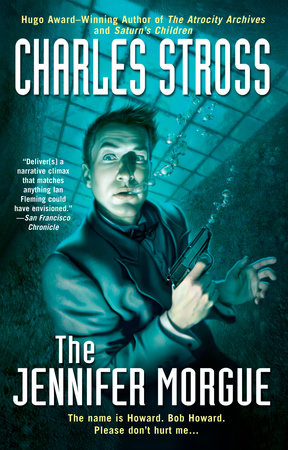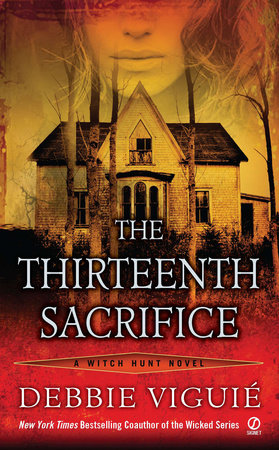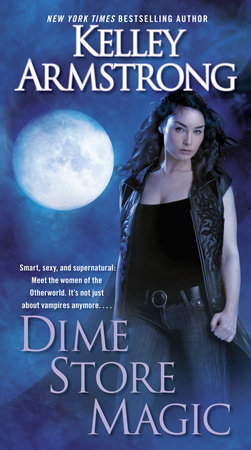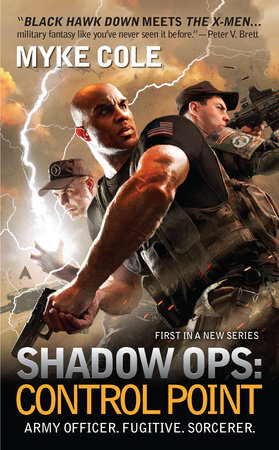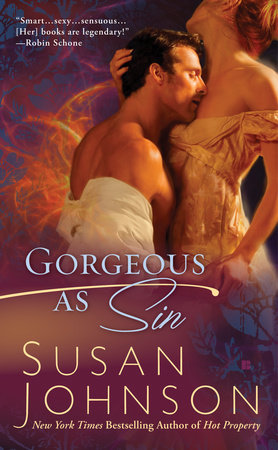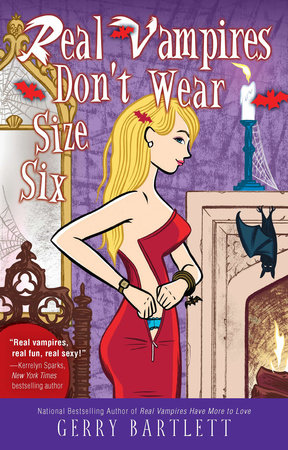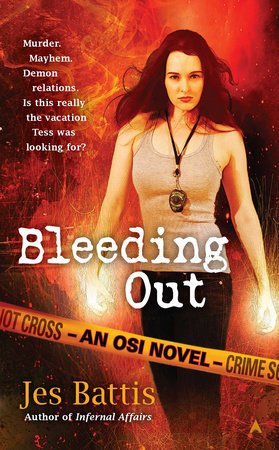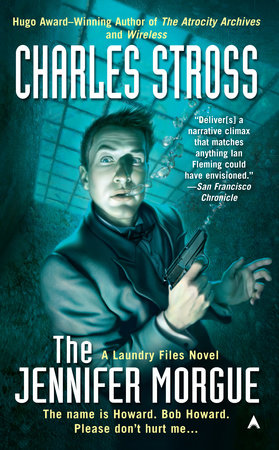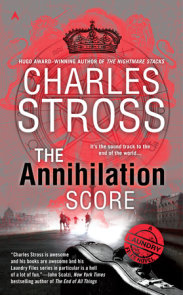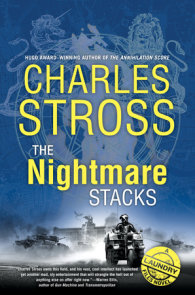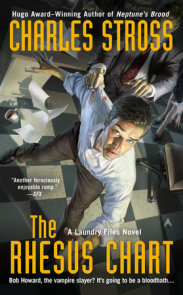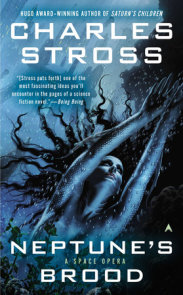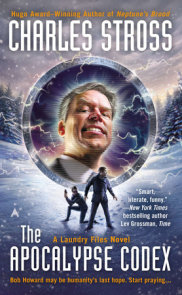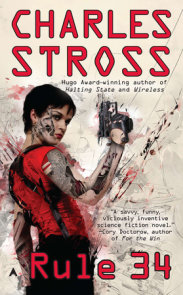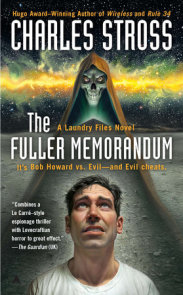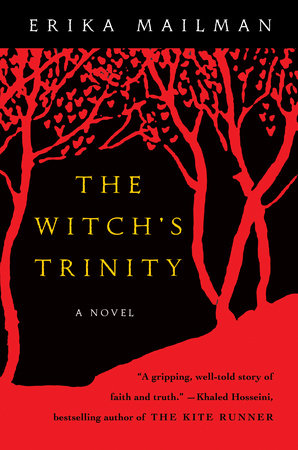Author Q&A
The Golden Age of Spying by Charles Stross
“My name is Bond. James Bond.”
These six words, heard by hundreds of millions of people, are almost invariably spoken during the first five minutes of each movie in one of the biggest media success stories of the twentieth century. Unless you’ve lived under a rock for the past forty years, you hear them and you know at once that you’re about to be plunged into a two-hour-long adrenaline-saturated extravaganza of snobbish fashionable excess, violence, sex, car chases, more violence, and blowing sh_t up—followed by a post-coital cigarette and a light-hearted quip as the credits roll.
It wasn’t always so. When Casino Royale was first published in 1953, it got a print run of 4,750 hardcover copies and no advertising budget to speak of; while the initial reviews were favourable, comparing Ian Fleming to Le Queux and Oppenheim (the kings of the pre-war British spy-thriller genre), it took a long time for his most famous creation to set the world on fire. Despite his rapidly rising print runs (Casino Royale eventually sold over a million paperbacks in the UK alone), and despite his increasing prominence among the post-war thriller writers, a decade elapsed before any of Fleming’s novels were filmed; indeed, their author barely lived to see the commercial release of Dr. No and the runaway success of the icon he created. (Nor were the films seen as a runaway success before they were made—Dr. No was notoriously made on a tight budget, even though it went on to gross nearly $60 million around the world.)
Literary immortality—or indeed, mere post-mortem survival—is dauntingly hard for a novelist to achieve. The limbo of post-mortem obscurity awaits ninety-five percent of all novelists—almost all novels go out of print for good within five years of the death of their author. But in addition to being a million-selling bestseller, Fleming was a ferociously well-connected newspaper executive with a strong sense of the value of his ideas, and he pursued television and film adaptation remorselessly. Cinematic success arrived just in time for his creation, and the synergy between bestselling books and massive movie hype has sufficed to keep them in print ever since.
James Bond is a creature of fantasy, perhaps best described using a literary term looted from that most curious and least respected of fields, fan fiction: the Mary-Sue. A Mary-Sue character is a placeholder in a script, a hollow cardboard cut-out into whose outline the author can squeeze their own dreams and fantasies. In the case of Bond, it’s cruelly easy to make a case that the famous spy was his author’s Mary-Sue, for Fleming had a curious and ambiguous relationship with spying.
A dilettante and dabbler for his first three decades, unsuccessful as a stockbroker, foreign correspondent, and banker, Fleming fortuitously landed his dream job on the eve of the Second World War: Secretary to the Director of Naval Intelligence in the Admiralty. The war was good for Ian Fleming, broadening and deepening him and giving him a job that captured his imagination and drew out his not inconsiderable talents. But Fleming was the man who knew too much: privy to too many secrets, he was wrapped in tissue paper and prevented from pursuing his desire to go into the field. He ended the war with a distinguished record—and absolutely no combat experience (if one excludes being bombed by the Luftwaffe or watching the Dieppe raid from a destroyer safely far off the Normandy coastline). Fleming grew up in the shade of a father who died heroically on the Western Front in 1917, and in adult life, he wrote in the shadow of an elder brother whose reputation as a novelist surpassed his own. It’s easy to imagine these unkind familial comparisons provoking the imaginative but flighty playboy who almost found himself during the war, which goaded him into imagining himself in the shoes of a hero who was not merely larger than life, but larger in every way than his own life.
And, as it turns out, James Bond was larger than Ian Fleming. Not only do few novels survive their author’s demise, even fewer acquire sequels written by other hands; yet several other authors (including Kingsley Amis and John Gardner) have toiled in Fleming’s vineyard. Few fictional characters acquire biographies written by third parties—but Bond has not only acquired an autobiography (courtesy of biographer John Pearson) but spawned a small cultural industry, including a study of his semiotics by Umberto Eco. Now, that has got to be a sign of something . . .
As with every true pearl, there was a sand-grain of truth at the heart of Bond. Fleming wrote thrillers informed by his actual experience. Years spent working out of the hothouse environment of Room 39 of the Admiralty building—headquarters of the Naval Intelligence Division of the Royal Navy—gave him a ringside seat on the operations of a major espionage organization. On various trips to Washington, DC, he worked with diplomats and officers of the OSS (predecessor organization to the CIA). There is also some evidence that, as a foreign news manager at the Sunday Times after the war, Fleming made his agency’s facilities available to officers of MI6. His first Bond novels were submitted to that agency for security clearance before they were published. Bond himself may have been larger than life, but the strictures imposed by the organization he worked for were drawn from reality, albeit the reality of an intelligence agency of the early 1940s.
The world of secret intelligence gathering during the Second World War was, however, very different from life in the intelligence community today. It was already changing by the late 1950s, as the bleeping football-shaped Sputniks zipped by overhead and intelligence directors began dreaming of spy satellites. By 2004, when MI5 (the counter-intelligence agency) openly placed recruiting advertisements in the press, we can be sure that Bond would have been best advised to seek employment elsewhere. Spies are supposed to be short—less than 180 centimeters [5 feet 11 inches] for men—and nondescript. As a branch of the civil service, MI5’s headquarters are presumably non-smoking, and drinking on the job is frowned upon. As intelligence agencies, MI5 and MI6 staffs aren’t in the business of ruthlessly wiping out enemies of the state: any decision to use lethal force lies with the Foreign Secretary, the COBRA committee, and other elements of the British government’s security oversight bureaucracy. An MI6 agent driving a 1933 Bentley racer with a supercharged engine, frequenting the high-stakes table at a casino as James Bond so memorably did in his first print appearance, is an almost perfect inversion of the real picture.
Nevertheless, the archetype has legs. James Bond continued to grow and evolve, even after his creator put away his cigarette holder for the last time. To some extent, this was the product of storytelling expediency. The film adaptations started in the middle of a continuing story arc—for Fleming wrote his novels with a modicum of continuity—and while Dr. No was the first to make it to celluloid, the novel was in fact a sequel to From Russia with Love (which was filmed second). Thus, various liberties were taken with the plot of the canonical novels right from the start. You can read the novels at length without finding anything of the banter between Bond and M’s secretary Moneypenny that is a recurrent theme of the films, for example, and that’s before we get into the bizarre deviations of the midperiod Roger Moore movies (notably The Spy Who Loved Me and Moonraker).
The literary James Bond is a creature of pre-war London clubland: upper-crust, snobbish, manipulative and cruel in his relationships with women, with a thinly veiled sadomasochistic streak and a coldly ruthless attitude to his opponents that verges on the psychopathic. Over the years, his cinematic alter ego has acquired the stamina of Superman, learned to defy the laws of physics, ventured into space—both outer and inner—and deflowered more maids than Don Juan. He’s also mutated to fit the prejudices and neuroses of the day, dabbling with (gasp!) monogamy, and hanging out with those heroic Afghan mujahedeen in the late-’80s AIDS-and-Soviets-era The Living Daylights. He’s worked under a post feminist ball-breaking ‘M’ in GoldenEye, and even confronted a female arch-villain in The World Is Not Enough (an innovation that would surely have Fleming, who formed his views on appropriate behaviour for the fairer sex in the 1920s, rolling in his grave). But other aspects of the Bond archetype remain timeless. Fleming was fascinated by fast cars, exotic locations, and intricate gadgetry, and all of these traits of the original novels have been amplified and extrapolated in the age of modern special effects.
Just how does James Bond—a “sexist, misogynist dinosaur, a relic of the Cold War,” to use the words the script-writers on GoldenEye so tellingly put into M’s mouth—survive in the popular imagination more than fifty years after his literary birth? What does it mean when Mary-Sue stalks the landscape of the imagination, blasting holes in the plot with a Walther PPK (or the P99 Bond upgraded to in Tomorrow Never Dies)? If we’re going to understand this, perhaps we ought to start by looking at Bond’s dark shadow, the Villain.
***
Bond is, if you judge him by his work, a nasty fellow and not one you’d choose to lend your car to. In order to make this rough diamond glitter it is necessary to display him against a velvet backdrop of darkest villainy. If you strip the Bond archetype of the bacchanalia, glamorous locations, and fashion snobbery, you end up with an unappetizingly shallow, cold-blooded executioner—the likes of Adam Hall’s Quiller or James Mitchell’s Callan, only without the breezy cynicism, or indeed any redeeming features at all. The role of adversary is thus a critical one in sustaining the appeal of the protagonist. Fleming set out to depict a hard-edged contemporary world where the usual black-and-white picture of the pre-war thriller had blurred and taken on some of the murky gray-on-gray ambiguity of the Cold War era; Bond was the knight in shining armour, fighting for virtue and the free world against the dragon—be they Mr. Big, Dr. No, Auric Goldfinger, or the looming shadow of Bond’s greatest enemy of all, Ernst Stavro Blofeld, Number One of SPECTRE, the Special Executive for Counter-intelligence, Terrorism, Revenge, and Extortion.
It is interesting to note that Blofeld assumed his primacy as Bond’s #1 enemy only in the movie canon; Fleming originally invented him while working on the screenplay and novel of Thunderball, and used him subsequently in On Her Majesty’s Secret Service and You Only Live Twice. (Prior to these later books, Bond typically tussled with less corporate enemies—Soviet stooges, unregenerate Nazis, and psychotic gangsters.) Blofeld was born out of mere corporate expediency. Rather than demonize the Soviets and reduce their potential audience, the producers of the film From Russia with Love appropriated SPECTRE as the adversarial organization. With the success of Thunderball, the third of the films, Blofeld moved front and center and acquired a life of his own that far exceeded his prominence in the novels. Arguably, Fleming’s death in 1964 freed up the movie series to diverge from their original author’s plans; and so Blofeld may be seen as a demon of necessity, conjured up from the vasty depths in order to provide Bond with a worthy adversary.
‘Twas not always so. Back at the turn of the twentieth century, around the time that the British spy thriller was gradually cohering out of the mists of the penny dreadful and the literature of suspense (via the works of John Buchan and Erskine Childers—not to mention the tangential contributions of Arthur Conan Doyle, by way of Sherlock Holmes) there was no great dualistic vision of the great champion confronting the villainous heart of evil. There was no great champion: we were on our own against the masters of night and mist, the great and terrible super criminals. Professor Moriarty, Holmes’s nemesis—the Napoleon of Crime—was but one of these: Fantômas, the 1911 creation of Pierre Souvestre and Marcel Allain, is another. The emperor of crime, Fantômas was a master of disguise and an agent of chaos (not to mention standing astride Paris in black mask, top hat and tails, in the posters for the 1913 movie of the same name: an icon of decadent wealth and criminal chaos). Nor was he alone. Guy Boothby’s 1890s super villain Dr. Nikola fits the bill too, right down to the fluffy lap-cat and the fiendish plans. But perhaps the root of Bond’s nemesis can be found in his full-fledged form somewhat later, and somewhat further to the east—in the guise of Dr. Mabuse.
Dr. Mabuse is an archetype and a runaway media success in his own right, famous from five novels and twelve movies. The Doctor was created by author Norbert Jacques, and was developed into one of the most chilling creations of the silent era in 1922 by no less a director than Fritz Lang. Mabuse is a name, but one that nobody in their right mind speaks aloud. He’s a master of disguise, naturally, and a rich, well-connected socialite and gambler. (Some social context: gambling at the high-stakes table is not so much an innocuous recreation as an obscenity, in a decade of hyperinflation and starvation, with crippled war veterans dying of cold on the street corners, as was the case in Weimar Germany.) Mabuse has his fingers in every pie, by way of a syndicate so shadowy and criminal that nobody knows its extent; he’s a spider, but the web he weaves is so broad that it looks like the whole of reality to the flies trapped within. He is (in some of the stories) a psychiatrist, skilled in manipulation, and those who hunt him are doomed to become his victims. If Mabuse has a weakness it is that his schemes are over-elaborate and tend to implode messily, usually when his most senior minions rebel, hopelessly late; nevertheless, he is a master of the escape plan, and with his ability to brainwash minions into playing his role he’s a remarkably hard phantom to slay.
It is all too easy to make fun of the likes of Fantômas and Dr. Nikola, and even their modern-day cognates such as Dr. Mabuse and Ernst Stavro Blofeld—for do they not represent such an obsessively concentrated pinnacle of entrepreneurial criminality that, if they really existed, they would instantly be hunted down and arrested by INTERPOL?
Careful consideration will lead one to reconsider this hasty judgment. Criminology, the study of crime and its causes, has a fundamental weak spot: it studies that proportion of the criminal population who are stupid or unlucky enough to get caught. The perfect criminal, should he or she exist, would be the one who is never apprehended—indeed, the one whose crimes may be huge but unnoticed, or indeed miscategorised as not crimes at all because they are so powerful they sway the law in their favour, or so clever they discover an immoral opportunity for criminal enterprise before the legislators notice it. Such forms of criminality may be indistinguishable, at a distance, from lawful business; the criminal a paragon of upper-class virtue, a face-man for Forbes.
When the real Napoleons of Crime walk among us today, they do so in the outwardly respectable guise of executives in business suits and thousand-dollar haircuts. The executives of WorldCom and Enron were denizens of a corporate culture so rapacious that any activity, however dubious, could be justified in the name of enhancing the bottom line. They have rightfully been charged, tried, and in some cases jailed for fraud, on a scale that would have been the envy of Mabuse, Blofeld, or their modern successor, Dr. Evil. When you need extra digits on your pocket calculator to compute the sums you are stealing, you’re in the big league. Again, when you’re able to evade prosecution by the simple expedient of appointing the state prosecutor and the judges—because you’re the president of a country (and not just any country, but a member of the rich and powerful G8)—you’re certainly not amenable to diagnosis and detection in the same sense as your run-of-the-mill shoplifter or petty delinquent. I’m naming no names (They have intelligence services! Cruise missiles!) but this isn’t a hypothetical scenario.
***
James Bond was a creature of the Cold War: a strange period of shadowboxing that stretched from late 1945 to the winter of 1991, forty-six years of paranoia, fear, and the creepy sensation that our lives were in thrall to forces beyond our comprehension. It’s almost impossible to explain the Cold War to anyone who was born after 1980; the sense of looming doom, the long shadows cast by the two eyeball-to-eyeball superpowers, each possessing vast powers of destruction, ready and able to bring about that destruction on a planetary scale in pursuit of their recondite ideologies. It was, to use the appropriate adjective, a truly Lovecraftian age, dominated by the cold reality that our lives could be interrupted by torment and death at virtually any time; normal existence was conducted in a soap-bubble universe sustained only by our determination to shut out awareness of the true horrors lurking in the darkness outside it, an abyss presided over by chilly alien warriors devoted to death-cult ideologies and dreams of Mutually Assured Destruction. Decades of distance has bought us some relief, thickening the wall of the bubble—memories misting over with the comforting illusion that the Cold War wasn’t really as bad as it seemed at the time—but who do we think we’re kidding? The Cold War wasn’t about us. It was about the Spies, and the Secret Masters, and the Hidden Knowledge.
It’s no coincidence that the Cold War was the golden age of spying—the peak of the second-oldest profession, the diggers in the dark, the seekers after unclean knowledge and secret wisdom. Prior to 1939, spying of the international kind rather than the sordid domestic variety (let us pass swiftly over the sordid Stasi archives of sealed glass jars full of worn underwear, kept as scent cues for the police dogs) was a small scale, largely amateurish concern. With the outbreak of the Second World War it mushroomed. Faced with employment vacancies, the first response of a growing organization is to recruit close to home. Just like any 1990s dot-com start-up, growing as the founders haul in all their friends and anyone they know who has the right skill set, the 1940s espionage agencies were a boom town into which a well-connected clubbable London playboy would inevitably be sucked—and, moreover, one where he might try his hand and succeed, to everyone’s surprise. (In the 1990s he’d end up in marketing, with stock options up to here. Sic transit gloria techie.)
When the Second World War gave way to the doom watch days and Strangelove nights of the Cold War, it entered a period in which the same clubbable fellow might find himself working in a mature organization, vastly larger and more professional than the half-assed amateurism of the early days. The CIA was born in the shadow of the wartime OSS, and grew into the emblematic Company (traders in secrets, over throwers of governments), locked in titanic struggle with that other super powered rival, the KGB (and their less well-known fellows in the GRU).
The age of the traditional sneak-spies with their Minox cameras gave way to the era of the bugging device. With the 1960s came a new emphasis on supplementing human intelligence (HUMINT) with intelligence from electronic sources (ELINT). New agencies—the NSA in the United States, GCHQ in the UK—expanded as the field of “spyless spying” went mainstream, aided by the explosion in computing power made possible by integrated circuits and, later, the microprocessor. As telephony, television, telex, and other technologies began to come online a torrent of data poured through the wires, a deluge that threatened to drown the agencies in useless noise. Or was it the whispering on the deep-ocean cables? Maybe the chatter served to conceal and disguise the quiet whispering of the hidden oracles, dribbling out strange new concepts that warped the vulnerable primate minds to serve their inscrutable goals. The source of the incredible new technologies that drove the advances of the mid-twentieth century was, perhaps, the whispering of an alien farmer in the ears of his herd . . .
Times change, and the golden age of spying is over. We’ve delivered the harvest of fear that the secret masters desired; or maybe they’ve simply lost interest in us for the time being. Time will tell. For now, be content that it’s all over: the Cold War was a time of strangely rapid technological progress, but also of claustrophobic fear of destruction at three minutes’ notice, of the thermonuclear stars coming and bringing madness and death in their wake. Retreat into your soap-bubble universe, little primate, and give thanks.
From the perspective of the twenty-first century, Bond was a poor archetype for a hero; certainly he couldn’t save us from the gibbering horrors of the Cold War, but only cast a shadow beneath their unblinking ground-zero glare. But we found salvation in the end, in the most unlikely place of all: if you turn on the TV, you’re likely to see one of Blofield’s protégés being held up for praise as an object of emulation. President of Italy, captain of industry, or chief executive of Enron—SPECTRE won and it’s their world that we live in, the world of the lesser evil.
